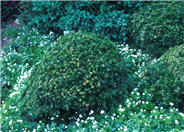
Common name:Compact Dwarf Boxwood
Botanical name:Buxus microphylla 'Compacta'
This is a very compact boxwood, growing slowing to 1 foot tall but eventually spreading as wide as 4 feet. though it is evergreen, the dark green foliage takes on a bronze hue in the winter months. Use to edge a perennial, shrub, or foundation border, to line a walk, or as an evergreen accent in the perennial garden. Its generally uniform growth habit means little maintanance is required to keep it tidy.
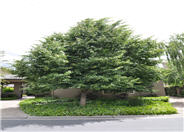
Common name:Little-leaf Linden
Botanical name:Tilia cordata
Little-leaf Linden is a deciduous shade tree that is pyramidal, growing about 50 to 70 feet tall and 30 to 50 feet wide, providing dense shade or screen. Leaves are broadly heart-shaped and dark green. Late spring blooms are yellow and fragrant, and followed by little brown nutlets. There are a number of cultivars available, providing some distinction in size and form. Shade, lawn, or screening tree.
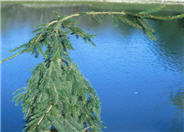
Common name:Weeping Norway Spruce
Botanical name:Picea abies 'Pendula'
Weeping Norway spruce is an artful accent evergreen with weeping, spreading branches. Spring growth is a bright green, with summer needles a rich green. Typically it is grown on a stake to feature its pendulous habit; it's height depends on where it is staked, but generally from 3 to 10 feet tall and up to 10 feet wide. It can also be grown as an undulating groundcover, draping over walls and slopes.
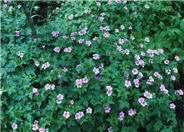
Common name:Endres' Cranesbill
Botanical name:Geranium endressii
This handsome perennial cranesbill has beautifully veined, soft pink flowers over slightly glossy, lobed foliage. Small pink, cup shaped flowers bloom in late spring to early summer. Leaves turn a lovely red in the fall. This plant reaches 12 to 18 inches tall and 18 inches wide. Endres' cranesbill is useful as a small area groundcover, or to fill in at the feet of larger perennials or shrubs.
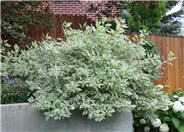
Common name:Ivory Halo Dogwood
Botanical name:Cornus alba 'Bailhalo'
Ivory Halo is a smaller version of variegated dogwood, growing about 5 to 6 feet tall and wide, wide a compact rounded habit. Leaves are light green and white, and red in the fall. Bark is red and provides wonderful winter interest, especially when planted infront of evergreens or solid fences. It produces white flowers in late spring, which are followed by blue-white berries. Use in the shrub or foundation border, and combines effectively cotoneaster, hydrangea, spirea, viburnum, and wiegala.
| Designer: | Green Corner 1 |
Photographer: GardenSoft |
Water Saving Tip:
Even though it's hot, your lawn only needs to be watered twice a week to stay healthy.
And don't water the whole lawn for a brown spot—drag out a hose.
